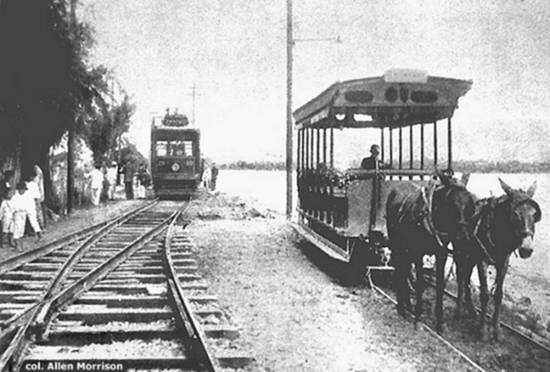 |
| Bonde 19 |
O bonde com prefixo 38 tem toda uma história, documentada com fotos, que se entrelaça com o processo de declínio e restauração desse sistema de transporte. Vamos encontrá-lo primeiro em Santos, com o prefixo original 19, em duas fotos de 13/08/1914, acima visto ao lado de um bonde com tração animal e abaixo durante a instalação da rede elétrica aérea:
The streetcar with prefix 38 has a history, documented with photos, which is intertwined with the process of decline and restoration ofthe transport system. We find him first in Santos, with the original prefix 19 in two pictures of 13/08/1914 above seen next to a trolley with animal traction and below during the installation of aerialelectric grid:
The streetcar with prefix 38 has a history, documented with photos, which is intertwined with the process of decline and restoration ofthe transport system. We find him first in Santos, with the original prefix 19 in two pictures of 13/08/1914 above seen next to a trolley with animal traction and below during the installation of aerialelectric grid:
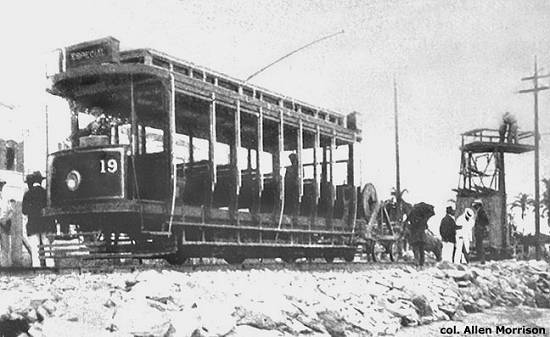 |
| Bonde 19 |
O bonde 19, agora com o novo prefixo 38, circula pelo centro de Santos (Rua General Câmara, entre ruas Itororó e Augusto Severo), na década de 1920, logo depois de ser adaptado como bonde fechado, apelidado de camarão devido à pintura em cor vermelha:
Tram 19, now with the new prefix 38, circulates through Santos (Rua General Camara, between streets Itororó and Augusto Severo), in the 1920s, soon after being adapted as closed streetcar, nicknamed the shrimp due to painting red:
Tram 19, now with the new prefix 38, circulates through Santos (Rua General Camara, between streets Itororó and Augusto Severo), in the 1920s, soon after being adapted as closed streetcar, nicknamed the shrimp due to painting red:
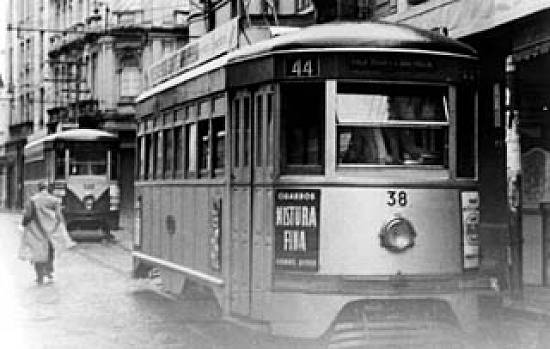 |
| Bonde 38 |
A foto, abaixo foi tirada pelo californiano Ralph Forty na Praça da Independência, em 9/3/1970. Mostra o mesmo bonde 19 reformado e fechado (nos anos 20) com o seu novo número 38:
The photo below was taken by californian Ralph Forty on Independence Square, on 03/09/1970. Shows the same tram 19retired and closed (20 years) with his new number 38:
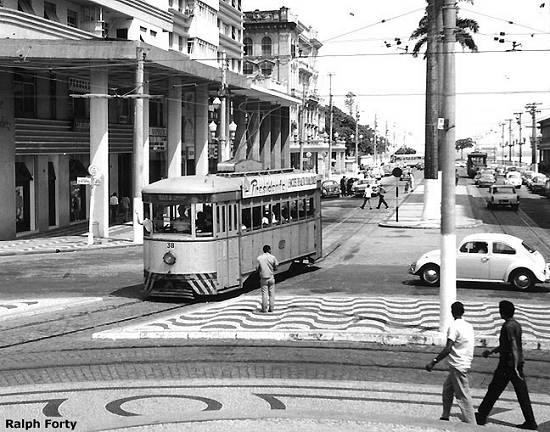 |
| Bonde 38 |
Menos de um ano depois, em 28/2/1971, o serviço de bondes em Santos seria desativado. Alguns bondes escaparam, destinados a museus. Como registra esta notícia do antigo jornal Cidade de Santos em 11 de outubro de 1973:
Less than a year later, on 02/28/1971, streetcar service wasdisabled in Santos. Some trams have escaped, for museums. Asnews of the old records this journal Santos City on October 11, 1973:
Less than a year later, on 02/28/1971, streetcar service wasdisabled in Santos. Some trams have escaped, for museums. Asnews of the old records this journal Santos City on October 11, 1973:
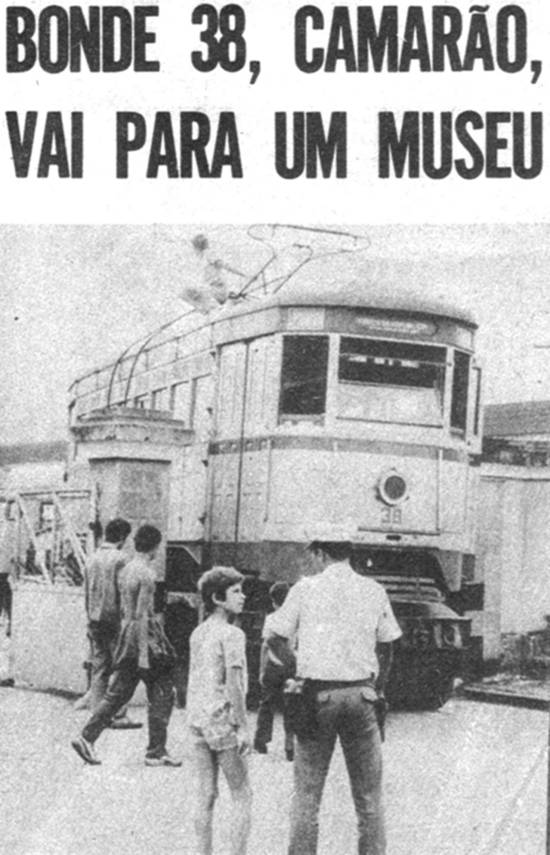 |
| Bonde 38 |
Tram 38 going to Sao Paulo in 1973:
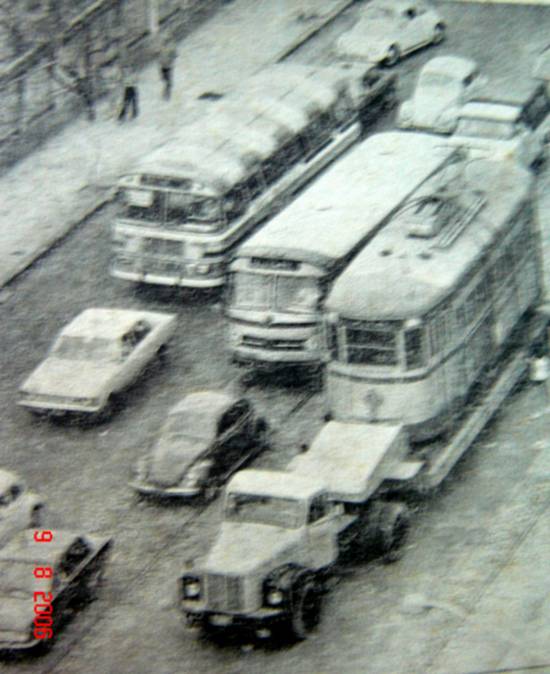 |
| Bonde 38 |
Mesmo bondes novos em folha, recém-saídos das oficinas, foram destruídos a machadas, junto com os demais. Uns poucos foram cedidos a parques infantis da cidade e a outras cidades, como Curitiba e Mairinque/SP. E esta foto do final da década de 1970 é de como aquela cidade paulista tratou o bonde 38 santista, visto ainda com as cores usadas no transporte coletivo santista em 1971:
Even streetcars brand new, fresh out of the workshops, weredestroyed with axes, along with others. A few were given the playgrounds of the city and other cities such as Curitiba andMairinque / SP. And this picture of the late 1970's is like that dealt with the city of São Paulo Santos 38 tram, because even with the colors used in the transportation of Santos in 1971:
Even streetcars brand new, fresh out of the workshops, weredestroyed with axes, along with others. A few were given the playgrounds of the city and other cities such as Curitiba andMairinque / SP. And this picture of the late 1970's is like that dealt with the city of São Paulo Santos 38 tram, because even with the colors used in the transportation of Santos in 1971:
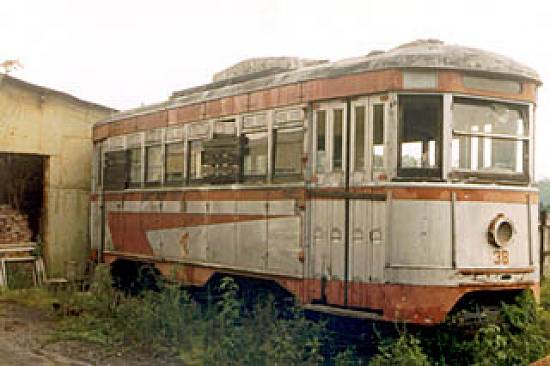 |
| Bonde 38 |
O Memorial do Imigrante obteve o veículo, levou-o para a capital paulista, onde fez a recuperação, transformando-o novamente em bonde aberto, só que agora com motor a gasolina:
The Immigrant Memorial received the vehicle, took him to the state capital, where he was recovering, transforming it into an open tramagain, only now with a gasoline engine:
The Immigrant Memorial received the vehicle, took him to the state capital, where he was recovering, transforming it into an open tramagain, only now with a gasoline engine:
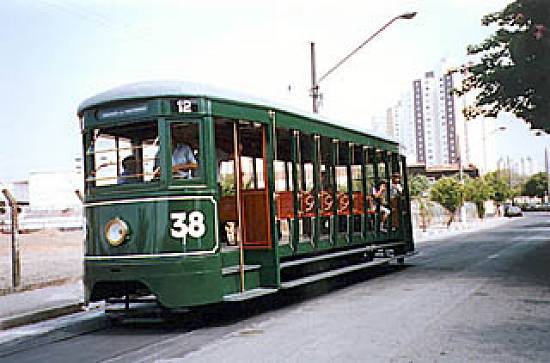 |
| Bonde 38 |
Os atos de depredação começaram em 2009, quando o mesmo parou de funcionar como passeio turístico, já que a CET mudou a mão do trecho da rua Visconde de Parnaíba que fica diante da estação Bresser-Mooca do Metrô, tornando impossível que o mesmo voltasse por aquele trecho da rua, sem cometer uma infração (trafegar na contra-mão). Com isso, os passeios foram paralisados.
Como o bonde ficava estacionado fora do Memorial do Imigrante, na rua, a vigilância nele não era muito eficaz. Tão logo ele ficou parado por um período mais longo, suas duas baterias foram furtadas. Não demorou muito e o velho escocês começou a sofrer furtos de peças e equipamentos, por parte de moradores de rua que as retiravam para vender. Neste sequência de roubos até o sistema hidráulico do veículo foi furtado, tornando assim impossível que ele voltasse a circular.
Em 2010 o Memorial do Imigrante foi fechado para reformas e a situação do bonde ficou ainda pior. Isolado na rua e sem ser protegido pelos vigias do museu, o veículo rapidamente virou banheiro e dormitório de moradores de rua. Para completar o circo de horrores, algumas chuvas fortíssimas fizeram o bonde ficar cheio de água por muitas vezes, e em uma ocasião dessas a tampa do motor foi levada pela enxurrada:
Em 2010 o Memorial do Imigrante foi fechado para reformas e a situação do bonde ficou ainda pior. Isolado na rua e sem ser protegido pelos vigias do museu, o veículo rapidamente virou banheiro e dormitório de moradores de rua. Para completar o circo de horrores, algumas chuvas fortíssimas fizeram o bonde ficar cheio de água por muitas vezes, e em uma ocasião dessas a tampa do motor foi levada pela enxurrada:
The acts of depredations began in 2009 when it stopped workingas a tour, since the CET has changed hands with the stretch of the street Visconde de Parnaiba that faces the station Bresser Moocathe Metro, making it impossible to return by the same that portionof the street, without committing an infraction (go against the hand).With that, the tours have been stopped.
As the tram was parked outside the Immigrant Memorial, on the street, surveillance it was not very effective. As soon as he stood for a longer period, its two batteries were stolen. Before long, theold Scot began to suffer thefts of parts and equipment, by thehomeless people who retreated to sell. Following this theft to the hydraulic system of the vehicle was stolen, making it impossible that he would circulate.
In 2010 the Immigration was closed for renovations and the tramsituation became even worse. Isolated on the street without beingprotected by guards of the museum, the vehicle quickly turnedbathroom and bedroom of the homeless. To complete the circus ofhorrors, some very heavy rains have made the boat fills with watermany times and in such a time the engine cover was taken by the flood:
As the tram was parked outside the Immigrant Memorial, on the street, surveillance it was not very effective. As soon as he stood for a longer period, its two batteries were stolen. Before long, theold Scot began to suffer thefts of parts and equipment, by thehomeless people who retreated to sell. Following this theft to the hydraulic system of the vehicle was stolen, making it impossible that he would circulate.
In 2010 the Immigration was closed for renovations and the tramsituation became even worse. Isolated on the street without beingprotected by guards of the museum, the vehicle quickly turnedbathroom and bedroom of the homeless. To complete the circus ofhorrors, some very heavy rains have made the boat fills with watermany times and in such a time the engine cover was taken by the flood:
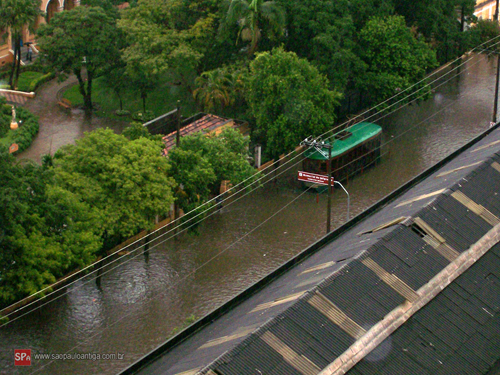 |
| Bonde 38 inundado |
Nenhum comentário:
Postar um comentário